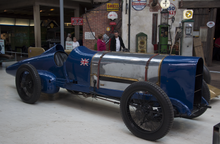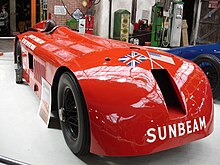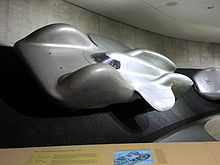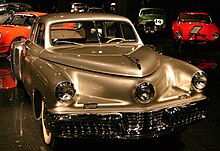Aero-engined car

An aero-engined car is an automobile powered by an engine designed for aircraft use. Most such cars have been built for racing, and many have attempted to set world land speed records. While the practice of fitting cars with aircraft engines predates World War I by a few years, it was most popular in the interwar period between the world wars when military-surplus aircraft engines were readily available and used to power numerous high-performance racing cars. Initially powered by piston aircraft engines, a number of post-World War II aero-engined cars have been powered by aviation turbine and jet engines instead. Piston-engined, turbine-engined, and jet-engined cars have all set world land speed records. There have also been some non-racing automotive applications for aircraft engines, including production vehicles such as the Tucker 48 and prototypes such as the Chrysler Turbine Car, Fiat Turbina, and General Motors Firebirds. In the late 20th century and into the 21st century, there has also been a revival of interest in piston-powered aero-engined racing cars.
Background
In the early 20th century,
Racing
Pre-World War I
A number of early European automobile manufacturers experimented with the automotive use of aircraft engines, including
Sunbeam also developed a second aero-engined car before World War I, which began life as an
Interwar period

1920s
By the 1920s, after the end of World War I, interest in and development of aero-engined cars reached a new level.[3] Coatalen built another aero-engined racing car, the Sunbeam 350HP, which featured a Sunbeam Manitou engine that had been designed to power Royal Naval Air Service flying boats. With an engine displacement of 1,118 cubic inches (18.32 L) and the ability to generate 355 hp (265 kW) at 2,100 rpm, the 350HP achieved a top speed of 134 mph (216 km/h) in 1922.[1]
In 1923, Ernest Eldridge began building the
Argentine racer Adolfo Scandroglio built his Fiat Botafogo Special in the image of the Mefistofele, using a 1917 Fiat chassis and the same 21.7-liter (1,320 cu in) Fiat A.12 engine that had been chosen by Eldridge. The car, which was named after a famed racehorse, was capable of producing 320 hp (240 kW) at 1,800 rpm. In 1949, Scandroglio was killed while racing the Botafogo Special, and the car was presumed to have been lost before its engine was rediscovered in the 1990s. After its rediscovery, the Argentine company Pur Sang, which is noted for creating exact replicas of Alfa Romeo 8C 2300s and Bugatti Type 35s, reconstructed the Botafogo Special. In 2011, the rebuilt car was purchased from Pur Sang by Jay Leno.[6]
In 1923, the Sunbeam 350HP was purchased by
Perhaps the most well-known aero-engined cars of the
Zborowski began working on a second car of the same name,
The third of Zborowski's cars,

Zborowski's fourth and final aero-engined car was the

In 1927,
1930s
In 1931, Campbell returned to competition with an upgraded Blue Bird that was sleeker and lower than its predecessor. Fitted with a 1,450 hp (1,080 kW) Napier Lion engine, the car successfully set a new land speed record with a run of 246.09 mph (396.04 km/h). By 1933, Campbell had created another Blue Bird that was powered by a Rolls-Royce R, which had achieved fame as the engine that helped the Supermarine S.6B seaplane win the Schneider Trophy. With this engine, which produced 2,500 hp (1,900 kW) and had a displacement of 36.7 liters (2,240 cu in), Blue Bird achieved a speed in excess of 272 mph (438 km/h) at Daytona. However, as performance continued to increase, the relatively limited area of Daytona Beach began to prevent cars from reaching their true top speeds. In September 1935, Campbell took Blue Bird to Utah's Bonneville Salt Flats, where it exceeded 300 mph (480 km/h).[1]
Ab Jenkins, who in October 1935 had set speed records for one hour and for 24 hours in a factory-modified Duesenberg SJ on a 10 miles (16 km) circuit marked out in the Bonneville Salt Flats,[12][13] realized that it was no longer possible for a modified production car to compete against aero-engined cars for long-distance speed records.[14] Jenkins had his SJ special further modified, replacing the modified SJ engine with a 25.73 liters (1,570 cu in) Curtiss Conqueror engine.[12][13] The Conqueror-engined special was named "Mormon Meteor" by a contest held by the Deseret News.[15] In 1936 the Mormon Meteor set the 500-kilometer (310 mi) record at 164.47 mph (264.69 km/h) (breaking a record set by George Eyston), the 24‑hour record at 153.82 mph (247.55 km/h), and the 48‑hour record at 148.64 mph (239.21 km/h). The Mormon Meteor set another 24‑hour record in 1937, averaging 157.27 mph (253.10 km/h). Jenkins then commissioned August Duesenberg to build a chassis that was better able to handle the weight, power, and torque of the Conqueror engine.[13] The result was the Mormon Meteor III, which broke the 12‑hour record in 1939[13] and set a 24‑hour record of 161.18 mph (259.39 km/h) in 1940.[16]

In 1937, Eyston brought his Thunderbolt to Bonneville, where its twin Rolls-Royce R engines powered it to a world-record speed of 312 mph (502 km/h). That year on the salt flats, something of a rivalry developed between Eyston and John Cobb, who had previously raced the 23.94-liter (1,461 cu in) Napier-Railton at Brooklands as well as at Bonneville. For 1937, Cobb had built the teardrop-shaped, streamlined Railton Special, which featured four-wheel drive and two Napier Lion engines. Over the span of just a few weeks, Eyston and his Thunderbolt set a new record of 345.49 mph (556.01 km/h), which Cobb and his Railton Special answered with a run of just over 350 mph (560 km/h), before Eyston retook the title by achieving 357.5 mph (575.3 km/h). The following year, 1938, Cobb returned to Bonneville and set a new world record of 369.7 mph (595.0 km/h), which would stand until 1947 due in part to the hiatus of competition caused by the outbreak of World War II.[1]

By 1939, the
Post-World War II
Piston-engined cars
After the conclusion of World War II, John Cobb returned to Utah in 1947, where he improved upon his own world record by achieving an official speed of 394.196 mph (634.397 km/h) in his rebuilt
In 1951, hot rod and drag racing enthusiast Art Arfons began building a series of aero-engined racing cars each known as the Green Monster. The first was a two-ton Ford truck chassis mated to an Allison V-1710 piston engine that was altogether capable of a record 144 mph (232 km/h) in a quarter-mile drag race. Arfons went on to build 12 more piston-engined Green Monsters before he began experimenting with jet engines.[1]
Turbine-engined cars

First raced in 1960, the
A number of other turbine-engined racing cars have been built, including two designed to compete for the world land speed record: Pioneer 2M and the Renault Étoile Filante.[20][21] Turbine-engined cars have also raced in other types of motorsports, including both open-wheel racing (Lotus 56 and STP-Paxton Turbocar) as well as sports car racing (Howmet TX and Rover-BRM).[22][23][24][25]
Jet-engined cars

In 1952, Soviet aircraft designer Aleksey Smolin developed the GAZ-TR, which was powered by a turbojet.[26] Built in 1954, it was designed to reach 500 km/h (310 mph), but due to the lack of adequate tires and an insufficiently long track it failed to exceed 300 km/h (190 mph) during a test run on November 14, 1954.[26][27] The GAZ-TR crashed during testing, injuring driver MA Meteleva and leading to the cancellation of the program. Wreckage from the car is on display at the GAZ factory museum.[26]
In 1962, jet engines made their first appearances at Bonneville in three different cars that were each based around the General Electric J47 engine, which also powered the North American F-86 Sabre jet fighter. One of the cars was the Flying Caduceus, which was driven to a speed of 331 mph (533 km/h) by Nathan Ostich, a physician who built the first jet car. The second was piloted by Glenn Leasher, who approached the 400 mph (640 km/h) mark before he was killed in a crash. The third was the needle-nosed Spirit of America, designed and raced by drag racer Craig Breedlove. Breedlove also contended for the speed record that year, although he did not capture the title until he recorded a speed of 407 mph (655 km/h) in 1963.[28]
In 1964, brothers Art and Walt Arfons arrived at Bonneville with jet cars of their own. Walt had acquired a Westinghouse J46 jet engine, which had been designed for the Vought F7U Cutlass, that he used to power his Wingfoot Express.[28] Art had opted for a General Electric J79, the same engine that powered the Lockheed F-104 Starfighter and the Convair B-58 Hustler bomber, and built a new, jet-powered Green Monster.[1][28] After Walt Arfons crashed and suffered a heart attack while testing the Wingfoot Express, designer Tom Green was selected to drive the car. Despite never having driven over 130 mph (210 km/h) before, on 2 October 1964 he piloted the car to a world-record speed of 413 mph (665 km/h).[28] The record stood for just three days, however, before it was broken by Art Arfons and his Green Monster with a speed of 434 mph (698 km/h).[1][28] Just one week after the Green Monster's record run, Breedlove broke the 500 mph (800 km/h) barrier before surviving a high-speed crash. The 1964 season ended with Art Arfons retaking the speed title when he made a run at 536 mph (863 km/h) after making modifications to his engine.[28]
In 1965, Breedlove returned to the Bonneville Salt Flats with his new

In 1970,
Jet-powered drag racing cars have also appeared in National Hot Rod Association (NHRA) events since the 1970s.[34] Jet cars were first sanctioned by the NHRA in 1974, and in 1980 official approval was granted for jet-powered Funny Cars.[35] In 1975, drag racer Phillip "Al" Eierdam created Emergency 1, a jet car powered by a Westinghouse J34 engine and stylized to mimic a fire engine. In the 1980s, Eierdam built and raced the rocket-engined Invader, often against his friend Sammy Miller and his rocket-powered Funny Car, Vanishing Point. The two contested the first side-by-side drag races between rocket-powered cars at Santa Pod Raceway in England.[34] By 1989, Roger Gustin had built more jet cars than anyone else in drag racing and had won the Jet Car Nationals on five separate occasions.[35] In the 2010s, jet cars have continued to be major attractions at NHRA events, participating in exhibitions such as four-wide races and achieving speeds in excess of 270 mph (430 km/h).[36] During the 2012 season, Elaine Larsen and Marisha Falk both drove jet dragsters powered by General Electric J85 engines capable of producing 5,000 hp (3,700 kW).[37]
Non-racing applications

Although rare, aircraft engines have occasionally been chosen as the powerplant for road-going cars. One prime example is the Tucker 48, which was produced in 1947 and 1948 and powered by a flat-six Franklin O-335 helicopter engine.[38] With a displacement of 5,473 cc (334.0 cu in), the engine produced 166 bhp (124 kW) at 3,200 rpm and produced a maximum of 372 pound-feet (504 N⋅m) of torque at 2,000 rpm, yet due largely to its all-alloy construction only weighed 320 pounds (150 kg).[38][39][40] The engine enabled the Tucker 48 to reach a top speed of approximately 120 mph (190 km/h) and to accelerate from 0 to 60 mph (97 km/h) in 10 seconds.[39] While the original O-335 helicopter engine was air-cooled, Tucker engineers modified it to water cooling, which helped improve the powerplant's durability while also giving the car the automotive industry's first fully sealed water-cooling system.[38][40]
In the 1960s, British engineer Paul Jameson and transmission specialist John Dodd collaborated to build
Turbine engines have also been utilized in
In 1954, Fiat introduced its own experimental turbine-engined prototype, the Turbina. The car was powered by a two-stage turbine that powered the wheels through a geared reduction unit, while its body was streamlined based on the results of wind tunnel testing. The Turbina's engine enabled it to achieve a top speed of 250 km/h (160 mph) as well as to produce 300 hp (220 kW) at 22,000 rpm.[46]

Introduced to the public in 1963, the Chrysler Turbine Car was powered by a turbine that produced 130 hp (97 kW) and 425 lb⋅ft (576 N⋅m) of torque, which made its output roughly equivalent to a 318-cubic-inch (5.21 L) V8 engine.
Revival

Even after the period in which they were competitive in the quest for the world land speed record, there has been continued and renewed interest in piston-driven aero-engined cars. One of the earliest cars created during this revival era is the

Aero-engined cars also made an appearance on the British television program
See also
- Aircraft engine
- Vehicles powered by Napier Lion engines
- Blastolene Special (custom-built car powered by a Continental AV1790-5B tank engine)
References
- ^ a b c d e f g h i j k l m n o p q r s t u v w Murphy, Daryl. "There's no Substitute for Cubic Inches: A Short History of Aero-engine Race Cars". Airport Journals. Airport Journals, LLC. Retrieved 19 November 2014.
- ^ "The Beast of Turin". StefanMarjoram.com. Stefan Marjoram Art & Photography. Archived from the original on 2 February 2017. Retrieved 26 January 2017.
- ^ a b "Aero-engined cars". Motor Sport. Motor Sport Ltd. July 1994. Retrieved 19 November 2014.
- ^ Mihalascu, Dan (3 April 2011). "Meet the Mefistofele, Fiat's 21.7-liter Record-Breaking Car from Hell". Carscoops. Retrieved 21 November 2014.
- Fiat Group Automobiles. Retrieved 21 November 2014.
- ^ Leno, Jay (24 September 2012). "The 1917 Fiat Botafogo Special—And its WWI Aircraft Engine". Popular Mechanics. Retrieved 28 November 2014.
- ^ a b "Sunbeam 350hp Bluebird". Beaulieu.co.uk. Beaulieu Enterprises Ltd. Retrieved 21 November 2014.
- ^ a b c d e "Chitty Bang Bang car". ChittyBangBang.com. Retrieved 19 November 2014.
- ^ a b "Aero-engined car on display". ITV News. ITV. 26 March 2013. Retrieved 19 November 2014.
- ^ a b "The Drivers". Beaulieu.co.uk. Beaulieu Enterprises Ltd. Retrieved 21 November 2014.
- ^ "Irving-Napier Special "Golden Arrow"". Beaulieu.co.uk. Beaulieu Enterprises Ltd. Retrieved 21 November 2014.
- ^ LCCN 90084421.
- ^ a b c d Leno, Jay (22 February 2009). "Jay Leno: Duesy Set Bonneville Records in 1930s that Stand Today". Popular Mechanics. Hearst Communication. Archived from the original on 28 September 2012. Retrieved 4 February 2015.
- ^ "Can Jenkins Best Eyston's Speed Record?". Deseret News. Salt Lake City, Utah, USA: Deseret News Publishing. 15 July 1936. Retrieved 4 February 2015.
- ^ "'Mormon Meteor' Chosen As Name For Jenkins' Car". Deseret News. Salt Lake City, Utah, USA: Deseret News Publishing. 1 August 1936. Retrieved 4 February 2015.
- ISSN 0032-4558.
- ^ SoftNews NET. Retrieved 3 January 2015.
- ^ a b "Bluebird". NationalMotorMuseum.org.uk. National Motor Museum Trust. Retrieved 21 November 2014.
- ^ "Bluebird CN7 - 50 years on". Punchline-Gloucester.com. Moose Partnership Ltd. 2012. Retrieved 21 November 2014.
- ^ "Pioneer". Soviet Sports Cars, Auto Rarities of USSR. Retrieved 21 November 2014.
- ^ Vautier, Maya (24 April 2014). "The Renault Etoile Filante, fastest car in the world". Renault.com blog. Renault. Retrieved 21 November 2014.
- ^ "Lotus 56 Pratt & Whitney". Ultimatecarpage.com. Retrieved 21 November 2014.
- ^ Blunk, Frank M. (31 May 1967). "Fate Rides Shotgun". The New York Times. Retrieved 21 November 2014.
- ^ "Howmet TX". Ultimatecarpage.com. Retrieved 21 November 2014.
- Heritage Motor Centre. 30 June 2014. Retrieved 21 November 2014.
- ^ a b c "GAS-TP (Turbojet)". Forgotten stars of the Soviet autoindustry. Retrieved February 9, 2020.
- ^ "Soviet Racing and Concept Cars". OldConceptCars. Retrieved February 9, 2020.
- ^ a b c d e f g Lerner, Preston (February 2009). "Oldies and Oddities: The Bonneville Jet Wars". Air & Space Magazine. Retrieved 22 November 2014.
- ^ Kirshenbaum, Jerry (27 April 1970). "A Speed King Without A Kingdom". Sports Illustrated. Retrieved 22 November 2014.
- ^ Ferguson, George (9 November 1970). "The run was a natural gas". Sports Illustrated. Retrieved 22 November 2014.
- ^ a b "Spirit Of Speed". Transport-Museum.com. Coventry Transport Museum. Retrieved 22 November 2014.
- ^ Resnick, Brian. "The World's Top 12 Fastest Vehicles: Thrust 2". Popular Mechanics. Retrieved 22 November 2014.
- ^ Resnick, Brian. "The World's Top 12 Fastest Vehicles: ThrustSSC". Popular Mechanics. Retrieved 22 November 2014.
- ^ a b "Veteran jet-car racer Eierdam dies". NHRA.com blog. National Hot Rod Association. 11 January 2012. Archived from the original on 22 November 2014. Retrieved 22 November 2014.
- ^ Sun-Sentinel. Retrieved 22 November 2014.
- ^ "Four-Wide Jet Cars, Charity Pancake Breakfast, Mobile Gaming and Much More All Part of the Dollar General NHRA Four-Wide Nationals". CharlotteMotorSpeedway.com. Speedway Motorsports, Inc. 12 April 2013. Archived from the original on 19 May 2013. Retrieved 22 November 2014.
- ^ "Extreme Jet Cars Heat Up Annual NHRA National Hot Rod Reunion at Beech Bend". NHRA Motorsports Museum website. National Hot Rod Association. 4 May 2012. Archived from the original on 4 March 2016. Retrieved 22 November 2014.
- ^ a b c "Tucker 48". Retro Car Icons. Retrieved 22 November 2014.
- ^ a b "Tucker 48 to be auctioned by Clars Auction Gallery". Old Cars Weekly. F+W. 6 May 2009. Retrieved 22 November 2014.
- ^ InfoSpace LLC. 13 June 2007. Retrieved 22 November 2014.
- ^ Marriage, Ollie (13 November 2008). "The Beast: evo10 Dream Drives: The Beast". Evo. Retrieved 28 November 2014.
- ^ "The Beast: 27 liters of Rolls-Royce power". AutoMinded.com. AutoMinded. 12 December 2012. Archived from the original on 3 January 2015. Retrieved 28 November 2014.
- ^ "1953 Firebird I". GMHeritageCenter.com. GM Heritage Center. Retrieved 23 November 2014.
- ^ "1956 Firebird II". GMHeritageCenter.com. GM Heritage Center. Retrieved 23 November 2014.
- ^ "1958 Firebird III". GMHeritageCenter.com. GM Heritage Center. Retrieved 23 November 2014.
- ^ "Fiat mod. Turbina". MuseoAuto.it. Museo dell’Automobile di Torino. Archived from the original on 21 March 2014. Retrieved 23 November 2014.
- ^ a b c Leno, Jay (11 April 2011). "Jay Leno Drives One of the Last Chrysler Turbines". Popular Mechanics. Retrieved 23 November 2014.
- ^ InfoSpace LLC. 11 November 2007. Retrieved 23 November 2014.
- ^ "Bentley-Napier". Motor Sport. Motor Sport Ltd. November 2004. Retrieved 23 November 2014.
- ^ English, Andrew (20 December 2010). "Christmas road test: Packard-engined Bentley". The Daily Telegraph. Retrieved 23 November 2014.
- ^ "Top Gear, Series 18, Episode 6". BBC.co.uk. BBC. Retrieved 23 November 2014.
- ^ a b "More from the Brutus and Bentley". TopGear.com. BBC. 6 March 2012. Archived from the original on 4 January 2015. Retrieved 23 November 2014.
- ^ a b "850bhp aero-engined Bentley for sale". TopGear.com. BBC. 2 January 2013. Archived from the original on 17 December 2014. Retrieved 19 November 2014.
- ^ Mihalascu, Dan (10 March 2011). "Fire Breathing BMW 46.0-liter V12-Powered Brutus Will Scare Even the Bravest Kids". Carscoops. Retrieved 23 November 2014.
